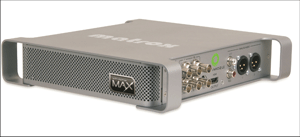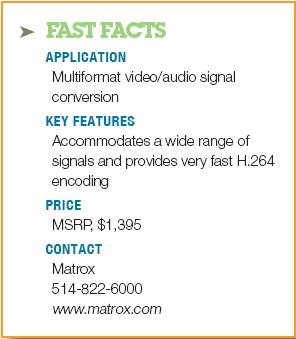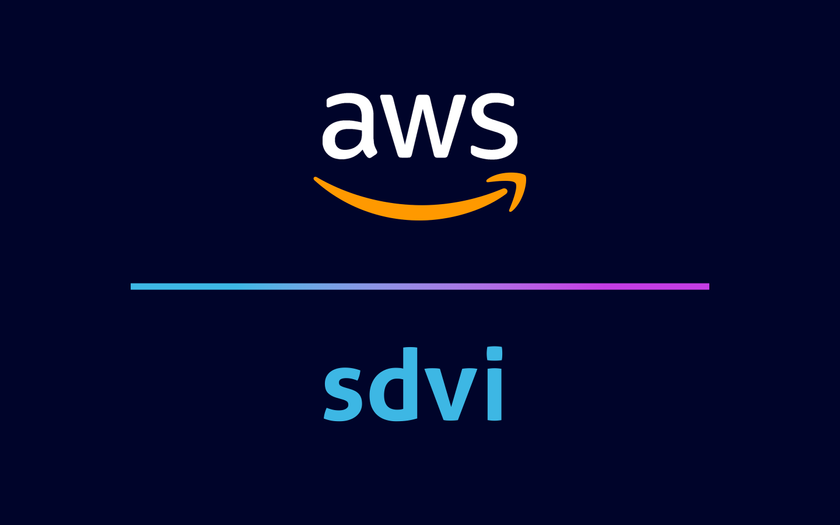Matrox MX02 LE MAX Signal Converter
The Matrox MXO2 LE MAX is an advanced breakout box that connects to a PC or Mac desktop or laptop, and provides real-time conversion of most existing video and audio formats. It also offers HDMI monitoring and highly accelerated H.264 video encoding. The Matrox MXO2 LE MAX is one of a family of similar I/O devices that vary in size, range of inputs and outputs, connectivity and price. These products are designed to connect to PC or Mac desktops or laptops via PCIe card, express34 card or Thunderbolt.
Matrox’s MXO2 LE MAX FEATURES
The Matrox MXO2 LE MAX has video inputs/outputs for signals including SDI, HDMI, component, S-Video and composite. Audio I/Os include XLR balanced and RCA unbalanced. There’s also a genlock port. Video formats can be cross-converted in real-time. HD to SD downscaling provides proper conversion of the SD color space and aspect ratio. SD to HD upscaling converts the SD color space to HD color space. SD footage with a 4:3 aspect ratio is pillar-boxed, while 16:9 footage is scaled to full screen. Cross-conversion between the 720 and 1080 HD formats is also provided.

The MXO2 LE MAX has two components— a PCI card that resides inside the host computer, and a rugged aluminum breakout box that contains all of the input and output terminals. It can also be confi gured to work with a laptop.
The breakout box is designed for simplicity, with all of the inputs on one side and all of the outputs on the other. As an example of its functionality, you can connect an analog component deck into the input side and play out SDI digital on the other in real time, or you could make multiple versions in different formats simultaneously by connecting devices to other live outputs, such as S-Video, HDMI or composite. Monitoring is constantly available through the HDMI port.
The real-time conversion of the MXO2 LE MAX is ideal for live streaming, enabling instant cross-conversion to formats suitable for the Web. And it’s compatible with popular streaming software, such as Adobe Flash Media Live Encoder, Telestream Wirecast, QuickTime Broadcaster, and Microsoft Expression.
The MXO2 LE MAX effi ciently provides professional monitoring for most popular editing systems, including Final Cut Pro X and 7, Avid Media Composer 6, Adobe Premiere Pro, and Boris Media 100.
The MXO2 LE MAX also includes a monitor calibrating system that allows you to precisely set your HDMI monitor to meet broadcast standards. This allows users to take a consumer-grade HDMI fl at screen TV and set it up as a professionally calibrated video monitor.
A real bonus offered by the MXO2 LE MAX is hardware-accelerated H.264 processing that dramatically speeds up the encoding process. H.264 has become a popular compression format and is used in everything from Internet streaming to Blu-ray disc encoding. However, as anyone who uses it knows, this is excruciatingly slow to encode. The MXO2 LE MAX encodes H.264 at about real-time speed, meaning that a one-hour program that might take fi ve hours using software-only encoding methodology can be done with the MXO2 LE MAX in about an hour.
IN USE
I set up the MXO2 LE MAX on a Mac Pro desktop running OS X Lion. This involved inserting a PCI card into a vacant slot and connecting a cable to the MXO2 external unit. I did initially encounter some diffi culty getting my Mac to detect the card. This step is a bit fi nicky, as the cable that connects to the MXO2 unit only works in one direction. Once I sorted that out, everything else fell into place.

I tested the MXO2 LE MAX fi rst with Avid Media Composer 6 and everything worked very well once I got the hang of the settings. First off, the MXO2 LE MAX is an excellent way to add HD monitoring to Avid Media Composer 6. The setup is simple and allows full HD monitoring from Media Composer, a feature that has been elusive in the past.
I tested out the monitor calibration feature, and found that it worked beautifully. It walks you through a series of visual setups that are very comprehensive and result in an accurate calibration. This is a very important feature, as it allows you to do color correction with the confi dence of knowing that you are working with a standardized monitor.
I was eager to test the accelerated H.264 encoding, as I use this codec frequently. On my fi rst attempt, I discovered I had the wrong driver. There are two for the MXO2 LE, so if you are using the MXO2 LE MAX, make sure you have the right one. Once that was sorted out, I found it easy to export projects directly from the timeline. I simply followed the export menu path from inside Media Composer, selected the Matrox MAX H.264 option and chose the desired settings.
After working with the Avid application, I then decided to test it on Final Cut 7. You can’t have both drivers for Avid and Final Cut operable at the same time, so I had to uninstall the Avid driver and install the Final Cut 7 driver.
I have to admit that I found this a bit inconvenient, as I use both NLE systems. I brought the matter up with the people at Matrox who explained that Final Cut 7 was designed for a 32-bit OS, while Media Composer 6 runs on 64-bit systems. Separating the drivers avoids problems and improves the performance of each. But moving forward, they plan to provide a unifi ed set of drivers that will allow a user to switch effortlessly between Final Cut Pro X and Avid Media Composer 6.
The MXO2 LE MAX worked identically on Final Cut 7 as it did on Avid Media Composer 6. I was able to connect the monitor effi ciently and have access to a long list of export codecs, including the Matrox MAX H.264. I encoded a 90 minute project in H.264 in about 90 minutes, and the quality was excellent.
I did encounter some bugs when exporting projects in certain formats and frame sizes. However, the Matrox support people were very attentive, provided excellent advice, and we were able to solve the problems to my satisfaction.
I have to say that I love the Matrox MAX H.264 feature. In the past I would have to wait four or fi ve hours to export an hour-long program. With the MAX H.264 feature, it takes about as long to export as the length of the program. And the compression settings are versatile and yield very high quality.
The Matrox MXO2 LE comes with its own record and playback utility, which provides a simple and fast way to record almost any source video to fi le in many formats. I tested it and found it to work effi ciently, saving the time and complexity of importing through NLE software.
I tested most of inputs including SDI, HDMI and composite. They all work as planned, plugging into one side of the box and playing out the other in your choice of SDI, HDMI, component, composite and SVideo. The breakout box is visually intuitive, making it easy to arrange connections.
SUMMARY
The Matrox MXO2 LE is a reliable and effi cient tool for cross-converting video formats from one system to another in real time. It also facilitates transferring any format to digital fi les through popular NLE systems, such as Final Cut Pro X and 7, and Avid Media Composer 6. I found the most useful applications on a day-to-day basis to be high-quality HDMI monitoring and high-speed encoding of video in H.264. It is a highly useful tool for any video editor who deals with multiple video formats.
Geoff Poister, Ph.D. is a member of the Film and Television faculty at Boston University and a regular contributor to TV Technology.
Get the TV Tech Newsletter
The professional video industry's #1 source for news, trends and product and tech information. Sign up below.













